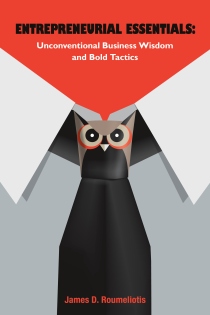Viewpoint by James D. Roumeliotis













Entrepreneurs may possess an abundance of passion for their small enterprise, but when it comes to promotion, value proposition, and building a brand their enthusiasm wanes. Building and nurturing a brand is what makes an enterprise gather wind under its wings.
No matter how small your venture may be, branding is essential. Branding is more than sticking a logo on a letterhead or business card.
Branding is the DNA of what you sell or do. Considering clients want to bond with a brand, you owe it to yourself to generate a story line. Buying today is so much more than a question of need. It is a question of relationship.
It is a given fact that a small enterprise will not have the budget or resources to implement a high powered show, outsource to an award winning agency or hire a PR/Marketing team to handle the ins and outs of this side of the business. However, what you do have or should have is creativity, innovative thinking, a sound understanding of your market, sweat equity and chutzpah.
Getting to grips with the differentials
The terms marketing and branding are often used interchangeably. This is a mistake in understanding. They are in fact two different concepts and should be understood as such.
Marketing is defined by the Chartered Institute of Marketing (CIM) as: “The management process responsible for identifying, anticipating and satisfying customer requirements profitably”.
Marketing provides strategic support to the sales function, by locating and nurturing qualified leads in order to reduce the cost of sale and shorten the sales cycle. To accomplish this, marketers use a variety of techniques, such as advertising, market research, and logo design.
The American Marketing Association (AMA) defines a brand as:
“A name, term, sign, symbol or design, or a combination of them intended to identify the goods and services of one seller or group of sellers and to differentiate them from those of other sellers.”
A brand is a promise of something that will be delivered by a business. This promise comes in a form of quality, an experience and a certain expectation in the mind of the consumer. Any viable small business must embrace branding, have a clear sense of identity and value proposition. Many start-ups typically make a cardinal mistake by thinking that they are just selling products or services. The organization of the firm may be sound, but a strong grounding in branding will make your venture a pure success story.
Branding in essence is the heart and soul of your venture. It sets your products or services apart from the competition. This is particularly true in certain sectors where price is the only differentiator. Competing just on price is a dead end game. The only firms who can win at this deal in high volumes and low margins. Small businesses cannot compete here. Service and experience therefore, should be added to the column of differentiators.
For example, local or neighborhood businesses which sell products with a reputable identity and favorable customer perception will invariably sell more and can command a better prices. Take the case of La Vie Claire in France. The franchise model has made these shops institutions in targeted neighborhoods. Most products are branded with the name of the store. Other brands are small or unknown. Sales at individual point of sales hinge on the service and advice of the resident manager. Given the price points of organic food, cosmetics, vitamins, mineral supplements clients seek a value added proposition to shop here on a regular basis. The key component is reliability, friendliness, and good products, which are fresh.

Consider the following keys:
1) Begin by defining your brand
Their is a small mens clothing boutique in the ninth arrondissement in Paris. The name is Husbands. It is off a main shopping street, but you would need a reference to know it exists. The brand ID is classic English tailoring ready-to-wear with a rock ‘n roll attitude. Fabrics are top notch and there are subtle detailing common to bespoke. Prices are moderate. However, if you are a new comer to the store, the first question you would ask yourself is: What is the unique selling proposition?
The owner of this store, will be happy to oblige you by talking to you about his passion and why the clothes are good value for money. However, is Husbands a brand? To the client, the answer is no. The story line of the brand and the store should be clear without an explanation.
2) Positioning
What do you want your brand to represent? Examine text book examples of brands that work. Don’t copy. Just learn the lessons and apply them to your brand in the making. A good case here is Hackett. When Jeremy Hackett first started out on the wrong end of the Kings Road, he understood that his brand had to embody something. In his case it was the essential British kit. Everything about the original concept captured the elegance of British tailoring without copying Savile Row. The store was old school for a new generation. The moment the press talked about his venture, the shop was off to the races.
The concept of Hackett was clearly defined from the beginning. Everything and I mean every detail was bonded into the brand and the DNA was solid and clear in any client who visited the premises.
3) Visual Identity
Neglect this point at your own risk. Color, lighting, furnishings, logo, bags, and so forth must speak with one unified voice. If the voice is mixed or unclear, your brand is dead in the water. Online presence must support the bricks and mortar entity. If you just sell online, fine. Just make sure their is one storyline, coherent, defining, and engaging. If it is, clients will act as ombudsmen. If it isn’t, you won’t make a single sale.
Take the case of Atelier de l’Armee based in Amsterdam. The strength of the brand ID is workwear, vintage, military. The concept revolves around craftsmanship with a contemporary voice of high quality and style.
4) Articulate your messaging
Ensure coherent communications online and offline. Three brands come to mind worthy of your attention: Ralph Lauren, Dolce & Gabbana, and DKNY. Each of these brands encapsulates a unique and distinctive vision. The products become the props to their fantasy worlds. The message delivery is always on target because they have been thought through with precision. Which ever value proposition you entertain, you must admit that the ID is engaging and speaks with its clients as valued partners not at them.
Advertising, events, sponsorships, promotions, direct marketing, customer relationship management are only the tools of the trade. The right messaging spearheads each component in a contiguous manner, which everyone finds engaging and wants to be part of. Does your brand accomplish this? If not, better go back to the story board.
5) Obsession
Often I have this discussion with colleagues and clients. It is about generating an obsession. Almost sounds like a perfume brand. Successfully generating obsession is the best sort of brand loyalty. Clients are enchanted and as mentioned before on this blog constitute a magic kingdom.
A year ago, Entrepreneur magazine had published an article by author Paula Andruss titled “The Secrets of 7 Successful Brands.” In it, she wrote that regardless how long ago those brands were launched, they all share one thing in common: They have figured out how to work their way into customers’ hearts, minds and wallets. Companies include online eye-wear retailer Warby Parker, TED and Pinterest, amongst others.

Branding for the private/professional practice
To develop a following requires a brand, and it doesn’t matter if you are a doctor, dentist, an accountant, or an attorney. All self-employed professionals should include it on their wish list. Your personal “brand” is what comes to mind when your “clients” are deciding whether to see you for the first or not.
Your credentials have much to do with your image in the consumer’s mind, so does your office ambiance and the courtesy (or lack of) offered the minute your staff greet the patient/client at the front desk. You may also be the doctor with bad breath or architect who is frequently late for appointments.
When branding your own private practice, you have the ability to carefully create a brand position that will appeal to your market and make your profession more successful through broader, or in some cases, very specific appeal. However, brand development requires time, energy, as well as a reasonable budget.
Personal brand positioning is the activity of creating an identity with a distinctive value in the target customer’s mind. For instance, when we think of an accomplished defense attorney, the first ones that spring to mind are those who have a reputation for having a high rate of litigation success – or cardiologists who are identified as utterly competent in curing most heart diseases and extending their patients’ life span. Essentially that is the position they occupy in your mind whenever you think of them.
Putting it all together
Branding significantly increases the overall value of brand equity. It’s proven that the brand value is ten times more than the physical assets of the company. It is more like investing in goodwill and this is priceless.
For a certain small businesses, the notion of marketing and branding remains unfamiliar territory. New business school grads however should approach this subject with eyes wide open. You can be a small fashion brand, boutique or even restaurant. Just examine the original Dean & Deluca, the gourmet food emporium, when it was located on Prince Street in SoHo, New York. The concept and vibe was pure branding genius.
Whatever path you choose, choose wisely. Create a brand with purpose. Give your audience a value proposition. Make them want to be part of your success story. Align your goals with an experience and the clients will come in droves.
Bonding with your audience also requires that you monitor the client’s behavior and the brand’s online reputation. Reputations can be fostered with either free or pay-for-service online tools such Google Alerts and Reputation.com. It is often advisable to conducting research among both your customers and employees. Timeframes can vary depending on your activity. Classic measurements take place either twice a year or annually.












_________________________________
Request your TWO FREE chapters of this popular book with no obligation.

Allow us to develop a sustainable brand for your existing SME/SMB or work on a strategy (with hands-on implementation) for your imminent start-up.
Inquire about our 30 minute free consultation

Google







































